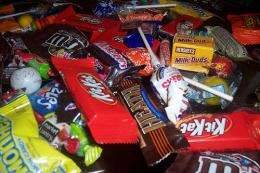Halloween candy: Facts and myths

(PhysOrg.com) -- A holiday devoted to vampires, goblins and ghouls is a recipe for a ghastly night of fright. But false stories of marauding strangers and poison-laced candy can make the evening scarier than it needs to be. Susannah Southern, RD, LDN, explains how to tell truth from fiction as you stay safe and well on Halloween.
Among the scariest Halloween myths is this one: Strangers are plotting to kill children by poisoning trick-or-treat candy. Such stories have prompted police departments to X-ray Halloween bags and the media to issue terrifying warnings.
The truth is that no genuine case of random child-poisoning related to trick-or-treating has ever been documented. (Eight-year-old Timothy O'Bryan died Oct. 31, 1974, after eating cyanide-laced Pixy Stix, but his own father was later convicted of the murder.)
Even if candy is unlikely to carry poison, it generally contains plenty of saturated fat and sugar. Read on to learn how you and your children can stay healthy on Halloween.
The claim: Dark chocolate is a health food, so you may indulge guilt-free
Recent research points to potential health benefits of dark chocolate. Some studies suggest that it can improve blood flow and blood-vessel function, and it may lower blood pressure.
“It's pretty exciting,” said Susannah Southern, RD, LDN, a dietitian in the Department of Family Medicine at the University of North Carolina at Chapel Hill School of Medicine.
But before you fill your cauldron with the magical stuff, remember that chocolates are high in saturated fat, which nutritionists blame for raising cholesterol and the risk of heart disease.
Researchers are still uncertain about how much dark chocolate you should eat to attain maximum benefits to your circulatory system, Southern said.
And watch out: Dutch-processed chocolate may not provide the same health boost as dark chocolate processed in other ways. (Check the label to determine how your chocolate was manufactured.)
The bottom line: To avoid overdoing it on the saturated fat, health-minded witches and warlocks should eat only a few squares of dark chocolate each week.
The claim: Fat-free candy is healthier than chocolate
Fat-free goodies such as hard candies and licorice don't contain saturated fat, so some people believe they are better for your body than chocolate. But sugary snacks can still pack plenty of empty calories, Southern said.
“I can eat a lot of Twizzlers before I get full,” she said.
Like alcohol, candy is considered a discretionary calorie, which means that it contains no nutritional value. In order to meet nutritional needs, most Americans should only consume 100 to 200 discretionary calories each day. But the majority of people actually eat 400 discretionary calories a day, Southern said.
“Sugar is replacing what we really need to be eating, and just popping a vitamin pill doesn't really do the same thing,” she said.
The bottom line: Like chocolate, you should eat fat-free candy only in moderation. And don't forget to eat plenty of vitamin-rich fruits and vegetables. (Some may also enjoy eye-of-newt.)
The claim: If you don't hand out candy, trick-or-treaters will toilet-paper your house
Many foods, such as fresh mango, taste just as good as candy. But because of packaging and safety concerns, those foods can be difficult to pass out to trick-or-treaters. Other options, such as packaged dried fruit, generally cost more than candy.
Since it's hard to avoid Halloween candy, start by teaching your kids year-round healthy eating habits. To do so, avoid using candy as a reward or a punishment, Southern said. But don't forbid them to eat candy, because then they will see it as special and desirable. When they do eat candy, keep portions small, and feed them plenty of nutritious food so they are not as hungry for sweets. Limit the amount of television they watch, because children's shows often contain processed-food advertisements. You can also help your kids to decide in advance how many pieces they are going to eat each day.












